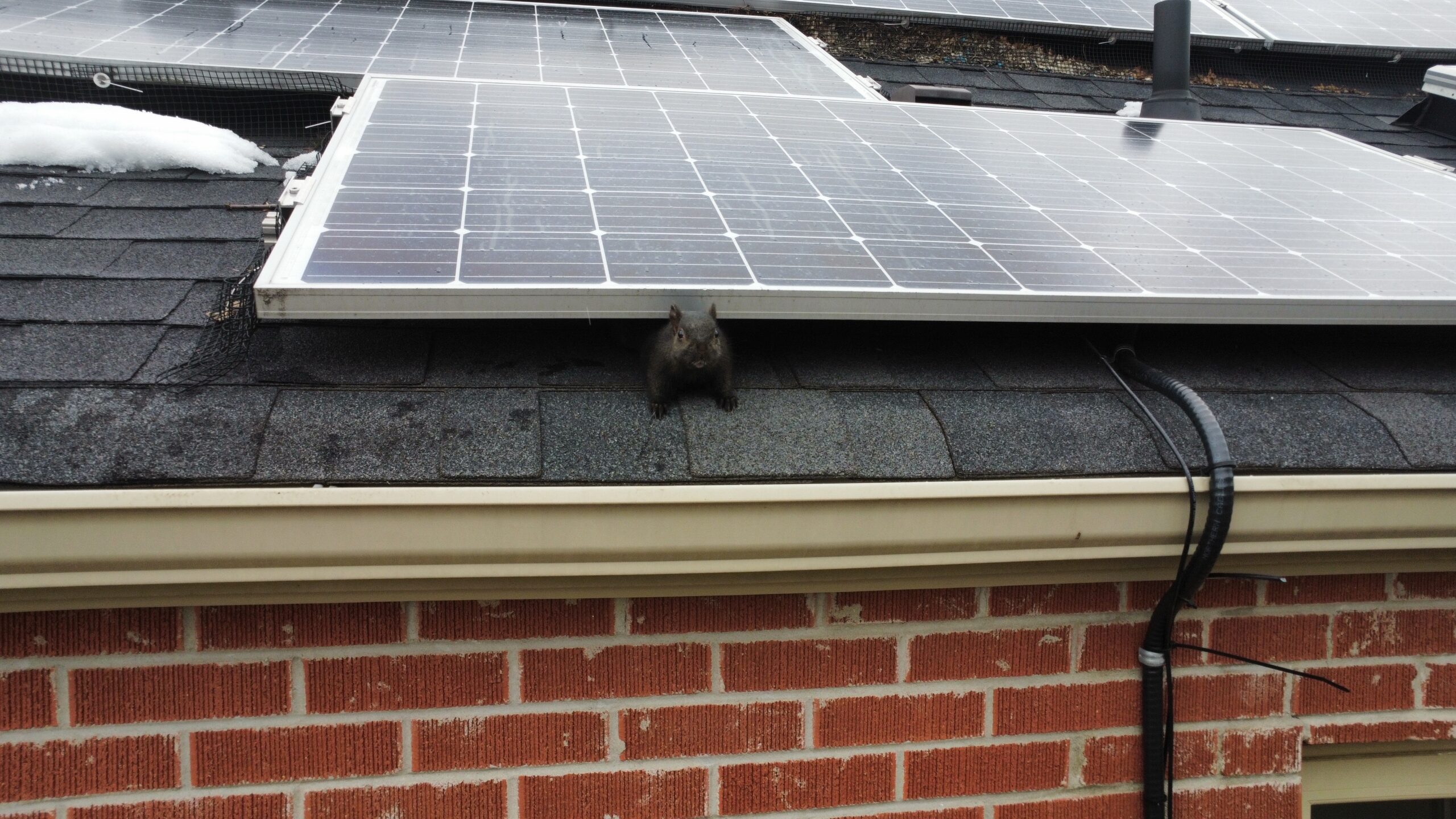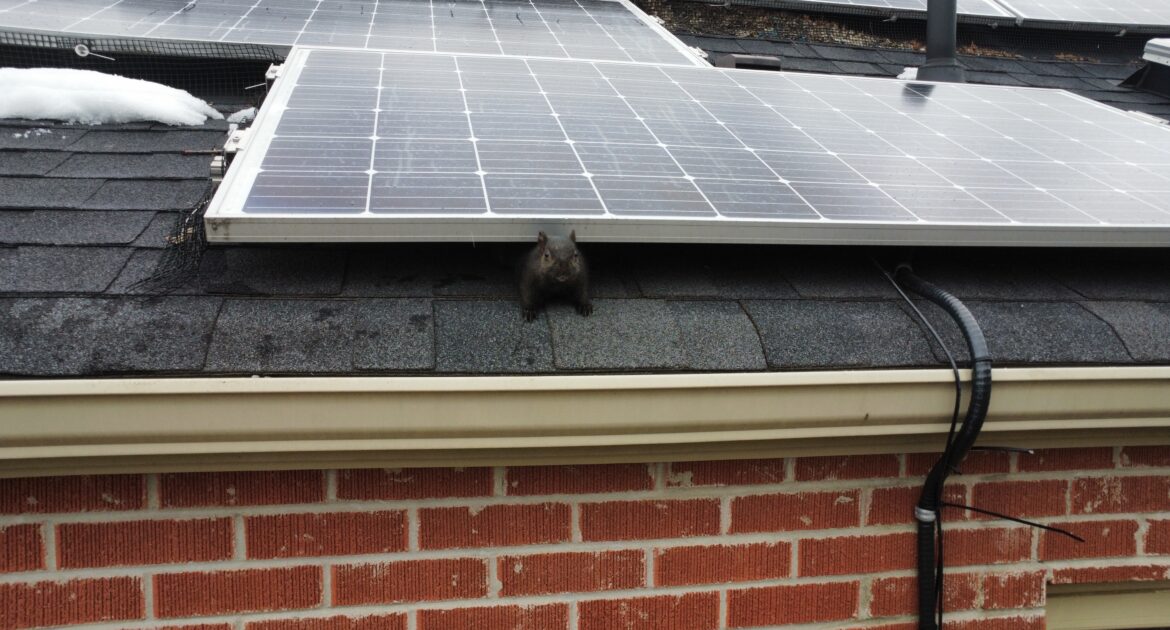Living in a place as vibrant and picturesque as Denver, Colorado, we’re used to sharing the outdoors with wildlife. Unfortunately, sometimes the outdoors tries to move indoors. Solar panels, which are popping up on more homes, offer the perfect hidden spot for wildlife to nest.
At Skedaddle Wildlife Control, we’ve seen it all, from pigeons setting up roost, to raccoons and squirrels finding ways to damage roofs and wiring. If you’ve noticed scratching sounds, droppings, or feathers near your solar panels, it could be wildlife staking its claim.
Here’s what we know about wildlife under solar panels, the problems they cause, and how our humane wildlife removal services at Skedaddle can protect your home.
Solar Panel Nesting Problems: The Damage Wildlife Can Cause
Roof-mounted solar panels are a fantastic, eco-friendly addition to any home, but they can also double as a prime hangout spot for wildlife. Installed on elevated rails, these panels leave a 4–6 inch gap underneath, offering just enough space for animals to settle in. This hidden area provides welcoming shade during Denver’s scorching summers and a safe, snug retreat from the biting wind chills of winter. The problem is that wildlife under solar panels can cause damage in several ways. While wildlife is nesting, they can wreak havoc on your panels and your home:
- Chewing wires: Squirrels have an unfortunate habit of gnawing on things, including electrical wiring. Left unchecked, this can lead to costly repairs or even electrical hazards.
- Roof damage: Animals like raccoons or mice can burrow into the roof beneath the panels, creating points of entry into your attic. This can lead to insulation damage, holes in your structure, and even water leaks after heavy rain.
- Clogged gutters: Nesting materials, feathers, droppings, and sticks often fall from beneath the solar panels and end up in your gutters. Over time, this can lead to clogs, causing water to back up and possibly damage your home’s exterior.
Pigeons, in particular, are one of the most common complaints we hear in Denver neighborhoods. They’re notorious for roosting under solar panels. Beyond their noise and mess, their droppings can corrode surfaces and diminish the efficiency of your solar panels over time.
The Risks of DIY Wildlife Removal
It might be tempting to grab a ladder and try to tackle the issue yourself, but wildlife removal is no simple task. Climbing onto a roof with solar panels adds an extra level of complexity and risk. You’re navigating around fragile equipment, dealing with slippery surfaces, and usually trying to coax wildlife out of small, hidden spaces.
Beyond the safety challenges, wildlife removal requires expertise. Without experience, you might unknowingly separate a mother from her offspring, creating more problems. Wildlife can also become aggressive when they feel cornered, putting you at risk of injury.
DIY methods don’t guarantee that wildlife won’t return. Unless their access points are sealed with durable materials and preventative measures are put in place, they’ll likely find their way back or cause even more damage trying to get in.
This is why professional help is so important. At Skedaddle Wildlife Control, we’re not just focused on removing wildlife temporarily—we’re here to protect your home for good.
How Skedaddle Approaches Humane Wildlife Removal
When you call Skedaddle, we start by thoroughly inspecting your property. This includes the solar panels, your rooflines, and any other areas where wildlife might be active. Once we’ve identified the issue, here’s how we tackle it:
- One-way doors: These ingenious devices allow wildlife to leave your home safely but prevent them from re-entering. It’s a humane solution that works for a variety of species.
- Heavy gauge mesh screens: To secure your solar panels, we install heavy gauge mesh screens around the perimeter. This creates a durable barrier that blocks animals from nesting underneath while ensuring your panels remain unaffected.
- Damage repair: If animals have already caused damage, we’ll fix it as part of our service, restoring your property to a wildlife-free state.
- Prevention strategies: We don’t just remove wildlife—we ensure they won’t come back. From sealing entry points to offering advice on keeping your property less inviting to animals, we take a comprehensive approach.
We’re proud to serve homeowners throughout Denver, providing sustainable and humane solutions to even the trickiest wildlife problems.
Common Wildlife in Denver Neighborhoods
Denver is full of thriving neighborhoods that wildlife also seems to love. From Stapleton to Capitol Hill, wildlife problems can pop up anywhere, particularly in places with plenty of trees or access to food sources like gardens. Below are some of the animals most commonly spotted in the area:
- Raccoons: Clever and persistent, raccoons can pry up roofing materials or tear into other weak points to gain access to your attic.
- Squirrels, Mice, and Rats: Natural climbers, these rodents are excellent at following power lines to rooftops and chewing through wiring to build nests. Wildlife chewing on the solar PV wiring beneath your panels can lead to serious problems. If the damage is extensive, you might face the costly replacement of multiple panels and microinverters. Beyond the financial burden, damaged wiring poses a significant electrical hazard that needs prompt attention to ensure your system remains safe and functional.
- Pigeons: A common sight in cityscapes, pigeons are frequent culprits when it comes to nesting beneath solar panels. Their droppings are highly acidic, which can lead to the gradual deterioration of shingles and other roofing materials. Over time, this waste often builds up in gutters and roof valleys, creating not only a messy and unpleasant cleanup job but also potential damage to your home’s drainage system.
- Bats: These quiet trespassers can fit into tiny openings often found around solar panels to get into your attic or eaves.
- Skunks: Though less likely to make it to your roof, skunks can settle under decks or near trash bins, adding another layer of trouble.
If you’re near local attractions such as Washington Park or the Denver Botanic Gardens, it’s worth noting these areas are hotspots for wildlife. Proximity to open spaces often makes your home more appealing to animals. It’s a good idea to take preventative measures early to avoid major issues.
A Cautionary Tale: Solar Panels And Wildlife
The family in Denver’s Park Hill neighborhood recently added solar panels to their home, excited about reducing their energy bills and their environmental impact. But not long after, they noticed an odd scratching sound coming from above their living room. At first, they thought it might be wind or debris, but the noises persisted. Then came the telltale signs: pigeon droppings on their driveway and a few loose twigs falling near their gutters.
Upon inspection, they discovered pigeons nesting under their solar panels. The birds had brought an army of twigs and debris, which clogged their gutters and caused water to overflow after heavy rains. Even worse, a few curious squirrels had joined the party, chewing on the wiring under the panels. What started as a small nuisance quickly became a costly headache, with roof damage that hinted at potential access to the attic.
Feeling overwhelmed, the family called Skedaddle Wildlife Control. Our team came out the same week, thoroughly inspecting the roof and panels for entry points or nests. Using humane one-way doors, we guided the pigeons out safely and sealed the perimeter of the panels with our heavy-gauge mesh screen, ensuring no wildlife could return. After cleaning out the debris and repairing the wiring, we also reinforced their gutters to prevent future clogging.
Now, the family can enjoy their solar panels without worrying about uninvited wildlife. By taking preventative steps early, they avoided further damage and learned the importance of professional, humane wildlife control. The family was thrilled with the results and now recommends Skedaddle to their neighbors with solar panels, knowing firsthand how quickly wildlife can take advantage of a cozy rooftop hideaway.
Protecting Your Roof and Home: Preventing Wildlife Under Solar Panels
Fortunately, you can avoid the headaches caused by wildlife under solar panels with a combination of proactive steps and professional services. Here are a few ways you can protect your property:
- Schedule regular inspections: Have your solar panels and roof checked regularly for signs of wildlife activity, nest materials, or damage.
- Keep your yard tidy: Secure trash cans, clean up food sources, and trim overhanging branches that offer animals easy access to your roof.
- Invest in preventative measures: Our heavy-gauge mesh screens are a long-term solution to keep your solar panels safe from unwanted visitors.
- Call in experts early: If you suspect wildlife has moved in, don’t wait. Contact professionals like Skedaddle Humane Wildlife Control to prevent the problem from escalating.
By taking a proactive approach, you can protect your solar panels, your roof, and your peace of mind.
Why Choose Skedaddle Wildlife Control?
At Skedaddle, we’re locals, and we understand the unique challenges Denver homeowners face when it comes to roof damage from animals. We prioritize humane removal methods and preventative solutions so you can feel good about protecting your home and the animals involved. With over 30 years of experience, we know how to handle wildlife problems safely, effectively, and compassionately.
From using one-way doors to installing heavy-gauge mesh screens, everything we do is designed to make your home a wildlife-free zone without compromising on humane treatment. If you’re dealing with wildlife under solar panels or just want peace of mind, give us a call. We’re here to help Denver stay wildlife-free, one rooftop at a time.




